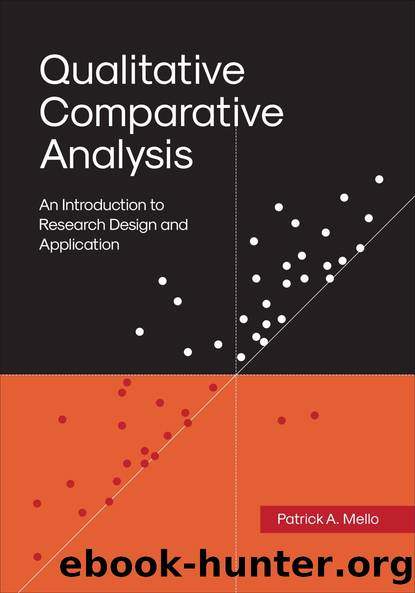Qualitative Comparative Analysis by Patrick A. Mello

Author:Patrick A. Mello [Mello, Patrick A.]
Language: eng
Format: epub
ISBN: 9781647121440
Google: wjU1zgEACAAJ
Barnesnoble:
Publisher: Georgetown University Press
Published: 2021-12-01T00:00:00+00:00
How does this look in practice? To illustrate the use of the RoN measure, let us take a simple example involving the condition X, the outcome Y, and hypothetical data on just four cases. Table 6.5 shows that, formally speaking, X is an almost perfect superset of Y because the values for X are almost always larger than or equal to the values for Y. On this basis, the condition X might be considered a necessary condition for Y.
The right-hand side of table 6.5 further shows the results for the calculation of the consistency and coverage for necessary conditions, and the relevance of necessity. As expected, we can see that at 0.95, the set-theoretic consistency is very high, satisfying the formal threshold for necessary conditions (equal to or above 0.90). The coverage is lower, but at 0.59 it would not immediately prompt concern. However, we can see that the RoN indicator is closer to 0 than to 1, suggesting a potentially trivial necessary condition.
Why is this? This being a hypothetical example, we have no substantive knowledge of the underlying data. But what we can see is that X shows little variation, with three of four cases at values equal to or close to 1. With data patterns like this, the consistency measure would always satisfy the criterion for a necessary condition. However, the RoN measure suggests that we should be cautious before treating it as a relevant necessary condition for the outcome. Ultimately, dealing with data patterns like this is a matter of interpretation. There can be situations where a condition is almost a constant, but still the condition may have substantive importance and relevance as a necessary condition. However, such an interpretation would need to be justified explicitly. As a rule of thumb, any potential necessary condition that meets the consistency benchmark of 0.9 should be checked for its coverage and relevance. If the latter two metrics fall below 0.5, this suggests that we may be dealing with a trivial necessary condition. In order to make an informed judgment on this, we should always examine the empirical distribution of our cases and their set-theoretic membership scores. A good way to do this are histograms and XâY plots of the raw and calibrated data (on this, see also chapter 10).
Download
This site does not store any files on its server. We only index and link to content provided by other sites. Please contact the content providers to delete copyright contents if any and email us, we'll remove relevant links or contents immediately.
Cecilia; Or, Memoirs of an Heiress — Volume 1 by Fanny Burney(32503)
Cecilia; Or, Memoirs of an Heiress — Volume 2 by Fanny Burney(31913)
Cecilia; Or, Memoirs of an Heiress — Volume 3 by Fanny Burney(31900)
The Great Music City by Andrea Baker(31761)
We're Going to Need More Wine by Gabrielle Union(19004)
All the Missing Girls by Megan Miranda(15788)
Pimp by Iceberg Slim(14440)
Bombshells: Glamour Girls of a Lifetime by Sullivan Steve(14024)
For the Love of Europe by Rick Steves(13643)
Talking to Strangers by Malcolm Gladwell(13300)
Norse Mythology by Gaiman Neil(13284)
Fifty Shades Freed by E L James(13189)
Mindhunter: Inside the FBI's Elite Serial Crime Unit by John E. Douglas & Mark Olshaker(9267)
Crazy Rich Asians by Kevin Kwan(9225)
The Lost Art of Listening by Michael P. Nichols(7456)
Enlightenment Now: The Case for Reason, Science, Humanism, and Progress by Steven Pinker(7275)
The Four Agreements by Don Miguel Ruiz(6704)
Bad Blood by John Carreyrou(6586)
Weapons of Math Destruction by Cathy O'Neil(6221)
